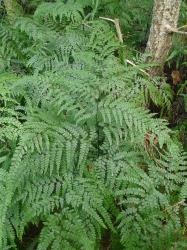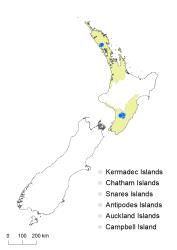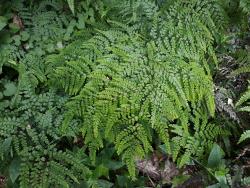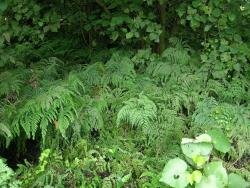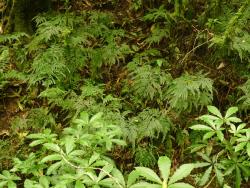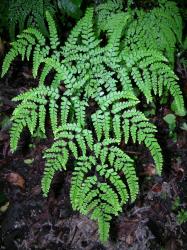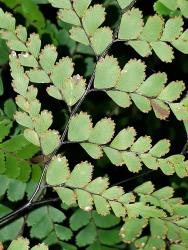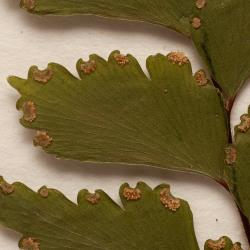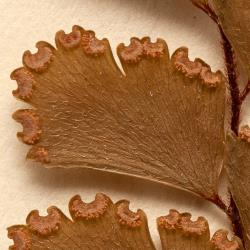- Taxon
- Gallery
Rhizomes long-creeping, up to 135 mm long (in herbarium specimens), 3–6 mm diameter, with stipes widely inserted; bearing scales; stolons and tubers absent. Rhizome scales narrowly ovate, 0.8–2 mm long, 0.1–0.3 mm wide, red-brown, appressed, concolorous. Fronds 470–970 mm long. Stipes 250–660 mm long, dark brown, tuberculate, rough, scattered scales proximally. Rachises dark brown, sulcate, sparsely tuberculate, slightly rough. Laminae usually 4-pinnate, or rarely 3-pinnate or 5-pinnate, broadly ovate, 200–450 mm long, 180–430 mm wide, dark green on both surfaces, herbaceous, glabrous on adaxial surface, glabrous or bearing pale flattened hairs on abaxial surface. 7–11 pairs of divided primary pinnae below long pinnate apex, overlapping, ovate or broadly ovate; costae bearing antrorse red-brown hairs; the longest pinnae at or near the base, 140–360 mm long, 110–320 mm wide, apices acute to acuminate, bases stalked, divided into secondary pinnae. 6–9 pairs of secondary pinnae on the proximal primary pinnae divided into tertiary pinnae; the longest secondary pinnae ovate or narrowly ovate, 75–220 mm long, 24–110 mm wide, apices acute to acuminate, bases stalked, divided into tertiary or quaternary pinnae, or rarely even more divided. Longest ultimate lamina segments oblong, 9–16 mm long, 4–8 mm wide, apices obtuse, acroscopic margins lobed or toothed, basiscopic margins ± entire, bases stalked, with stalks attached in one corner. Reflexed lamina flaps lunulate, glabrous.
Adiantum formosum is the largest and most divided of the indigenous species in New Zealand. It is usually 4-pinnate at the base but small fronds may occasionally be 3-pinnate and large fronds rarely 5-pinnate. It has oblong ultimate segments with the stalk attached in one corner, rough but glabrous stipes and rachises, hairy costae on the pinnae, lunulate and glabrous “indusia”, and a green abaxial lamina surface. Plants from Northland (now believed extinct) have pale hairs on the abaxial lamina surfaces, but those from the Manawatū are glabrous.
North Island: Northland, Auckland, Southern North Island
Altitudinal range: 50–90 m.
Adiantum formosum is currently found only in lowland sites around the Manawatū Gorge. It was formerly collected from the Wairoa River and Kaipara Harbour in Northland, but is now thought to be extinct in that region. Collections from Whangārei need confirmation, possibly having come from cultivated plants, or labelled with a broad and imprecise locality, and they are not mapped here. There are no collections in AK, CHR or WELT to substantiate records from Reef Point and Herekino (Crookes 1963; Bartlett 1980), and they must be regarded as suspect. The species is easily cultivated and it is unclear whether populations adjacent to the Manawatū Gorge, at Linton, Lake Horowhenua and in native forest at Masterton, are natural or the result of plantings, and they are not mapped here. Populations in Auckland city, Titirangi, Waitākere, Pukekohe and Pukekura Park are definitely cultivated.
Also Australia (Queensland, New South Wales, Victoria). Naturalised in Sri Lanka (Fraser-Jenkins et al. 2017).
In the vicinity of the Manawatū Gorge, Adiantum formosum grows on river terraces and streambanks under podocarp/broadleaved forest and scrub. It also occurs under pines and willows.
Adiantum formosum was given a conservation status of At Risk – Relict by de Lange et al. (2018).
n = 58 (Brownlie 1961).
Adiantum formosum in Australia is dimorphic with respect to hairs on the abaxial lamina surfaces – some populations are glabrous, others bear pale, flattened hairs. The fact that, in New Zealand, plants from Northland are hairy but those from elsewhere are glabrous suggests these populations have resulted from at least two different dispersal events. The two forms have not been given any taxonomic recognition in Australia (Bostock 1998) and are treated here as dimorphic character states within A. formosum (Brownsey et al. 2019).



